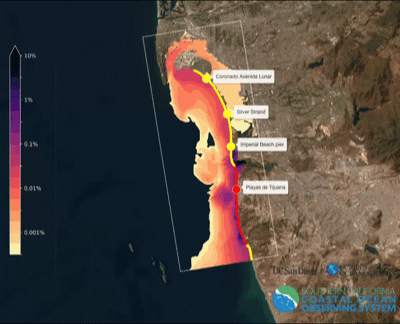Scripps Oceanography Researchers Unveil User-Friendly Tool to Alert Beachgoers to Contamination
Website provides forecasts of sewage concentration along coast up to five days in advance
Story by:
Published Date
Article Content
Scientists at UC San Diego’s Scripps Institution of Oceanography present a new tool the public can use to understand sewage contamination levels at beaches from Coronado to Playas de Tijuana as well as potential risks of swimmer illness.
Haga clic aquí para leer en español
The Pathogen Forecast Model hosted by the Southern California Coastal Ocean Observing System (SCCOOS) at Scripps shows the forecasted levels of sewage in the coastal ocean in the San Diego-Tijuana border region together with illness risk for ocean swimming. The Pathogen Forecast Model website provides detailed forecasts for Playas Tijuana, Imperial Beach, Silver Strand State Park, and Coronado of shoreline sewage concentration as well as estimated risk of illness for ocean swimmers. The aim is to enable families to make informed decisions about whether to take their kids to the beach on the weekend.
“The Pathogen Forecast Model has considerable skill in predicting five days into the future the beach water quality measurements made by San Diego County from Imperial Beach to Coronado,” said Scripps oceanographer Falk Feddersen, the project lead. “Of course, just like with weather forecasts, the model has error. It is still experimental.”
Feddersen and coastal physical oceanographer Sarah Giddings have led research on pollution transport in the region for several years. In 2015, an experiment in which researchers released pink dye to reveal the movement of nearshore currents in Imperial Beach provided an illustration of pollution transport up the coast. In 2021, the team developed a coastal ocean, pathogen and human-illness model for the border region that included sewage sources from the Tijuana River and the San Antonio de los Buenos (SAB) treatment plant in Punta Bandera. The new Pathogen Forecast Model further advances that research into a predictive tool that takes in data on winds, tides, offshore currents, waves, and river flow to estimate ocean transport and compute risk.

The public tool responds to a longstanding problem of raw sewage from Mexico circulating in the coastal ocean on both sides of the border. Ocean currents often transport sewage flows parallel to the coast northward to San Diego beaches leading to closures and impacts to the community’s physical and mental health. Other research from UC San Diego scientists suggests that pathogens and chemicals sourced to the sewage can become airborne even several miles inland.
The model was developed with funding from the state of California to protect public health while officials seek ways to address the sewage problem at its source.
“I applaud the progress made by Scripps Institution of Oceanography to develop a model capable of predicting swimmer illness risk up to five days in advance,” said Calif. State Senator Steve Padilla, whose district includes the entire California–Mexico border. “Communities like Imperial Beach have been at the epicenter of this crisis for a generation, and they deserve real, science-driven solutions. This tool gives critical, science-based insight to inform timely beach management decisions, protect the health of beachgoers and help minimize impacts to local businesses. I look forward to future model developments, which will only help restore confidence in the safety of our coastline as we work to stop this public health crisis at its source.”
Additional funds for expansion of this tool were included in the Fiscal Year 2026 Commerce Justice Science and Related Agencies Appropriations bill approved by the House Appropriations Subcommittee last week. The full Committee is scheduled to consider the bill on Thursday.
“I was pleased to see the committee include this Community Project Funding request, as it will give our regional partners the data they need to make critical, science-driven decisions,” said U.S. Representative Scott Peters (CA-50). “I’ve worked hard to secure federal investments in the infrastructure projects needed to stop the cross-border sewage crisis at its source and end the devastation of our environmental and public health. As those projects move forward, this predictive model will be essential to monitor conditions during construction and ensure those solutions are working as intended upon completion.”
Communities like Imperial Beach have been at the epicenter of this crisis for a generation, and they deserve real, science-driven solutions. This tool gives critical, science-based insight to inform timely beach management decisions, protect the health of beachgoers and help minimize impacts to local businesses.
The researchers emphasize this is not a beach advisory or closure tool. Official beach water quality conditions are reported daily by the County of San Diego Beach & Bay Water Quality Monitoring Program. Advisories, warnings, and closures are updated daily and can be found at County of San Diego Beach Water Quality. The County of San Diego also maintains the Tijuana River Valley Sewage Crisis Environmental Dashboard.
“The Pathogen Forecast Model is a forecast of the shoreline sewage concentration and our five day forecast has good correlation with the County’s sampling data,” added Feddersen.
The research team plans to work to continually improve the Pathogen Forecast Model. In the next phase planned for summer 2026, it will contain a validated forecast of the pathogen norovirus for improved swimmer illness risk forecasts, Feddersen said.
Additional principal investigators in the project are Jeff Bowman, Andrew Barton, Uwe Send, Bruce Cornuelle, Ganesh Gopalakrishnan and Clarissa Anderson.
Share This:
You May Also Like
Stay in the Know
Keep up with all the latest from UC San Diego. Subscribe to the newsletter today.




